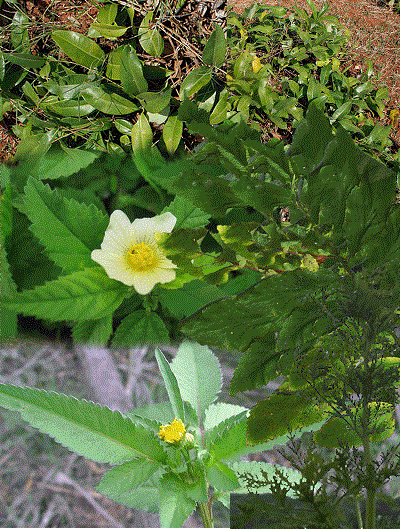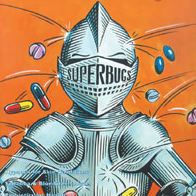Positive Health Online
Your Country

Conventional vs. Herbal Antibiotics - What Is The Difference?
listed in infections and inflammation, originally published in issue 212 - February 2014
Have Conventional Antibiotics Outlived their Use?
One of the hottest topics today is the overuse of conventional antibiotics and the loss of their effectiveness. The Centers for Disease Control and Prevention in the United States (CDC) reports that prescription antibiotics have led to a catastrophic rise in super bugs, causing the death of 23,000 Americans each year after successful operations; an estimated 50,000 death occurs in hospitals after successful operations in Germany.
In the Threat Report 2013 of the CDC it admits that modern medicine is a failure when it comes to infectious diseases, since Mother Nature adapts to chemical threats far more quickly than drug companies can roll out new chemicals. Recently we have become aware of the harsh side-effects and severe limitations of pharmaceutical drugs. In particular, antibiotics have shown to cause even greater injury to the body, by killing both helpful and harmful bacteria. The immune system is compromised by the lack of helpful bacteria in the body and the harmful bacteria that have increased their resistance to antibiotics because of overuse.
Hospital-acquired resistant infections, by conservative estimates, are now the leading cause of death in the United States. You will find in many books written by professionals including medical doctors, for example Confession of a medical heretic by Dr Robert S Mendelsohn MD who states that “hospitals these days are the most dangerous place on earth because they are breeding grounds of super bugs due to the lack of proper hygiene by doctors and nurses; many have become a disease-infested death trap!!” The Danish physician Peter C Gotzsche writes in his book Deadly Medicines and Organized Crime, “Everything we know about drugs is what the companies have chosen to tell us and our doctors. Although our doctors are very knowledgeable about some things, such as human physiology, which is vital in treating patients, they know very little about drugs that hasn't been carefully concocted and dressed up by the drug industry.”
When using an isolated chemical to combat disease rooted in a 1950s mentality that has nearly reached its endpoint in the history of medicine, is it any wonder that we have created an area of no return. Due to the disastrous failure of antibiotics combined with the widespread suppression of human immune system function (due to drugs, hazardous chemicals in the air, food, water, household and garden goods, cosmetics and personal care products, genetically modified and engineered food, (GMOs) super bugs death are quickly accelerating and are getting out of control.
What about Penicillin?
The first antibiotic - penicillin - was discovered in 1929; after that new antibiotics were developed daily and the arsenal of medicine seemed overwhelming. There were voices of concern especially from Alexander Fleming, the discoverer of penicillin who warned that improper use of it would lead to the development of resistant bacteria. But it seemed that nobody was listening in the medical profession and as a result we lost control! Comment from Dr Tom Frieden, Director of CDC “The area of antibiotics is rearing its end and if we are not careful, we will soon be in a post-antibiotic area.!”
This admission should really send alarm bells ringing across the medical establishment since it means the day is not far off when doctors and hospitals no longer can offer treatments for common infections. It is feared that the problem will further accelerate and that it may only be a matter of time when new diseases will appear with absolutely no treatments available for them! Only people who possess the nearly lost knowledge of natural plant-derived antibiotics will have any real chance of surviving such an outbreak if they become infected.
Drug companies are refusing to invest in new antibiotics which are not nearly profitable as other areas of drug research as a solution to the super bug problem they caused. The incentives to produce more and better antibiotics only kick in under the worst circumstances, when millions of people start to die from antibiotic-resistant infections!
Here are some Interesting and Frightening Statistics
According to Dr Shiv Chopra, former scientist at Health Canada (HC) for 35 years, who rejected the injection of bovine growth hormone into cows as a whistle blower. He was fired by HC in 2007, and as a result no injections have taken place. Dr Chopra said at a lecture November 19, 2013 in Vancouver, British Columbia to a packed crowd about genetically modified engineered food and human health that 80% of antibiotics are used in animals (primarily pigs, cattle, chicken, farm fish etc).
Antibiotics are excreted in millions of pounds from millions of people in hospitals each year; xpired antibiotics are simply thrown into the garbage including antibacterials, disinfectants, antibiotic remnants from different treatments which are part of the hospital waste streams, ending up in treatment plants and which pass relatively unchanged into our world's water supply.
More Bad News
260 million antibiotic prescriptions yearly are dispensed by American physicians outside of hospitals and excreted into the environment. Pharmaceutical manufacturers discharge additional thousands of tons of spent mycelial and other antibiotic related waste into the environment, plus nearly 30 million pounds are dispensed by the American factory farms (huge animal slaughter houses); millions of their excrement is funnelled into waste lagoons, flowing relatively unchanged into local ecosystems. Additional antibiotic-laden faeces from millions of open range farm and domestic animals (mostly dogs and cats) disposed directly onto the ground.
Conclusion
Stuart Levy, physician and researcher comes to the conclusion that worldwide environmental dumping over the past 65 years of such huge quantities of synthetic antibiotics has created the most pervasive impacts on Mother Earth's bacterial underpinnings since oxygen-generating bacteria supplanted methanogens 2.5 billion years ago. As a result it has stimulated evolutionary changes that are unparalleled in recorded biologic history. We need to be aware that this means the emergence of unique pathogenic bacteria in human, animal, and agricultural crop population and also the emergence of infectious epidemics more deadly than any in human history!
Is there an Alternative and / or a Solution to all of This?
In the last 20 years and since the internet a lot has changed, a renaissance of medical plants has taken place - check the website of Chris Kilham, www.medicinehunter.com - especially in Africa, Asia, South America, within the Russian sphere and most of Eastern Europe.
Many of the researchers and scientists in these countries have realized that corporate profit making and human health are not compatible with addressing health problems without any profit motive. It is no secret that big international pharmaceutical corporations have betrayed the consumers and make billions out of the misery of others. The United States has been left behind using an outdated model that has no effective place in the real world! For anyone who wants to learn more about the wonders of botanical plants should read the book The Secret Life of Plants by Peter Tompkins and Christoper Bird, a fascinating account of the physical, emotional, and spiritual relations between plants and man.
Medical Doctors have never been informed of the powerful antibiotic properties of colloidal silver, garlic, onions, copper, Aloe Vera gel, iodine, full spectrum earth Himalayan crystal and sea salt (even sea salt can be contaminated), sulphur compounds, Chinese, native North American, Aboriginal and India Ayurveda medicine herbs and many other bacteria fighting substances from the botanical world.
Systemic Herbal Antibiotics
Herbal medicines spreading by the bloodstream throughout the body are systemic antibacterials. They affect every cell and organ in the body, working actively against different bacteria. These herbs are treating infections such as MRSA, spread throughout the body and not responding to multiple antibiotics treatments; therefore the importance of systemic herbal antibacterials cannot be overstated.

The Five Top Systemic Herbal Antibiotics
- Cryptolepis sanguinolenta: Flowering plant in the Apocynaceae family, extract from the root is also traditional used in West Africa (Angola, Lagos, Belgian Congo, Gambia) to treat malaria and type II diabetes. All members of this genus contain the antibacterial alkaloids cryptoepine, quindoline and neocryptoline. There are many more of this plant but Cryptolepis sanguinolenta is the most potent of them. Can be prepared as powder, capsules, tea, or tincture. Strong antibacterial resistance to infections;
- Sida acuta (also called Common Wireweed): there are a huge number of species, estimated up to 200 or more, belongs to the mallow family, malvaceae from Central America, roots leaves, stems, seeds are used. The herb is also used to prevent pregnancy and should not be used when trying to get pregnant and for eye infections, against herpes viruses, Lyme disease, malaria, dysentery, as a pot herb for primary protein source, skin rashes, fevers, infections, diarrhoea, anaemia. Used as powder, capsules, tea, or tincture. Strong antibacterial resistance to infections;
- Alchornea castaneifulia: (Christmas bush), plant genus of Euphorbiacease family, group of plants of some 60 species in the Amazon rainforest of Brazil, Alchornea cordifolia from indigenous Africa. Leaves, bark, stem, roots and fruits are used. Antifungal, antitumour, crop and soil restorer, fruits produce a black dye used for fishing nets, clothes, pottery, leather. Used as powder, tea, or tincture. Strong antibacterial resistance to infections;
- Bidens pilosa: belonging to the Asteraceae family (compositae): there are close to 200 species, leaves and roots are used, works against chronic diarrhoea, mucous membranes, dysentery, inflamed respiratory passages, malaria, blood tonic, to be used as tea, decoction, cold infusion, fresh juice, tincture. Strong resistance to antibacterial infection;
- Artemisia anna: (sweet Annie, sweet wormwood): there are approx. 400 artemisias in the genus but Artemisia anna contains the most artemisinin, a potent anti-parasitic, the aerial parts and flowers have the highest artemisinin content, treatment for malaria, blood parasites, fever, liver, antiviral, female reproductive problems. Used as infusion, juice or tincture. Strong resistance to antibacterial infection.
The Top Four Localized Nonsystemic Herbal Antibiotics Are:
- The Berberines: used as powder, tincture, capsules, powder, as a douche and a wash;
- Juniper: tincture from berries, infusion, decoction, as berrie, powder, steam, essential oil;
- Honey: externally for burns, ulcerations, bedsores, infected wounds, impetigo, seborrhoeic dermatitis, internally as a preventative, acute conditions, colds and flu tea;
- Usnea: wound powder, tincture, tea,, douche, wash, nasal spray, immune stimulation, and disease prevention.
For more detailed information about these top five systemic and the four nonsystemic herbal antibiotics please read the book Herbal Antibiotics - Natural Alternatives for treating drug-resistance bacteria, by Stephen Harrod Buhner.
Words of Wisdom
Look deep, deep, deep into Nature and you will understand everything.
Albert Einstein, German Physicist, (1879 1955)
References
Buhner, Stephen Harrod, Herbal Antibiotics, Storey Publishing, 2nd edition. 2012.
Offit, Paul A., MD, Breaking The Antibiotic Habit. Wiley. 1999.
Kamaraju, V., Narasimam, R.L., Current Trends in Antibiotic Resistance in Infectious Diseases, IK International Publishing House Pvt Ltd. 2009.
Burke, A. Cuna, Antibiotic Essentials, Jones & Bartlett Learning, 2013.
Schmidt, Dr. Michael A., Beyond Antibiotics, North Atlantic Books. 2009.
Tompkins, Peter, Bird, Christopher, The Secret Life of Plants, Harper Perennial, 2002.
Fried, Stephen, Bitter Pills, Inside the hazardous world of legal drugs, Bantam Books. 1998.
Fitzgerald, Randall, The Hundred-Year Lie, How to protect yourself from the chemicals that are destroying your health, Penguin Group. 2006.
Gotzsche, Peter C. Deadly Medicines and Organized Crime, How Big Pharma has corrupted healthcare, Radcliffe. 2013.
Further Information
This information is offered for its educational value and should not be used in the diagnosis, treatment, or prevention of disease. Please contact your health care practitioner.
Comments:
-
No Article Comments available
